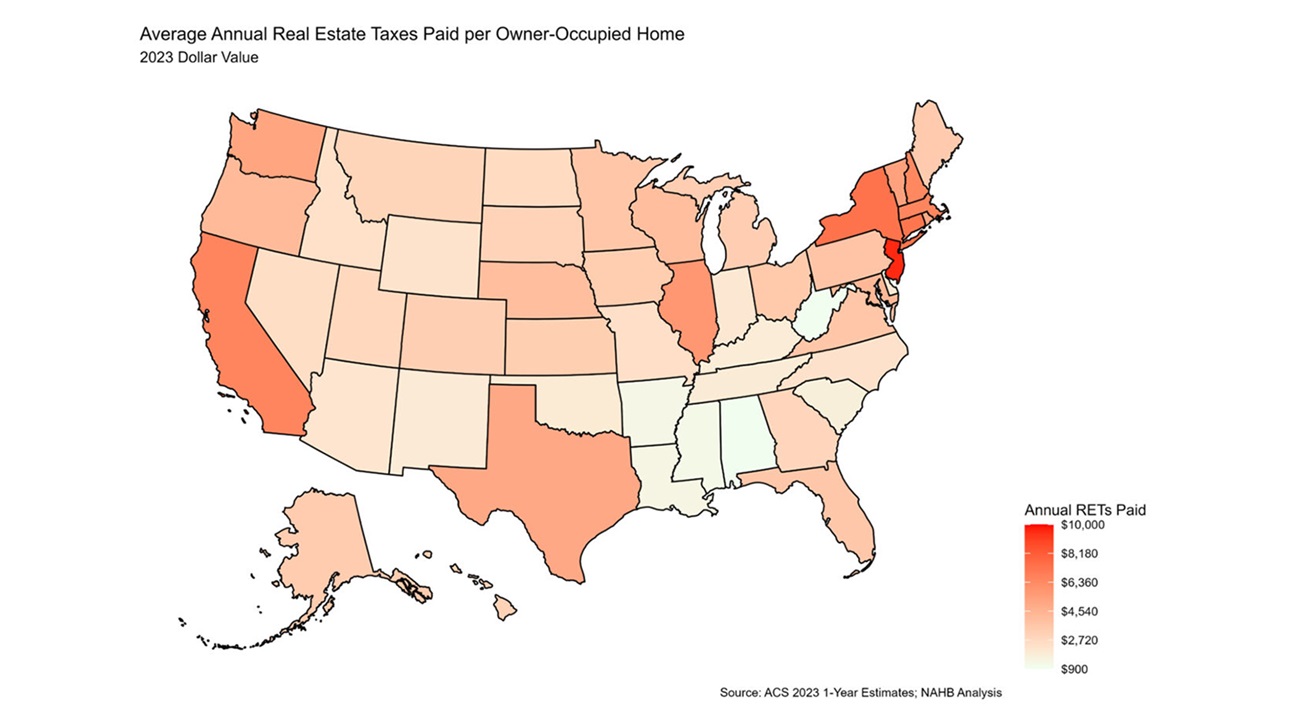How Much Did Home Owners in Each State Pay on Property Taxes in 2023?

The average annual real estate taxes paid in 2023 across 86 million owner-occupied homes nationwide was $4,112, according to NAHB analysis of the 2023 American Community Survey. Compared to 2022, every state saw increases in the average amount of real estate taxes paid.
New Jersey continued to pay the highest real estate taxes, with an average of $9,572. That number is 30.6% higher than the second highest amount of $7,329 paid by New York home owners. The largest percentage increase was in Hawaii, up 21.1% from $2,541 to $3,078.
On the other end of the distribution, home owners in Alabama paid the lowest average amount of real estate taxes at $978. The smallest increase was in New Hampshire, up 1.1% from $6,385 to $6,453.
Average Effective Property Tax Rates
Although average annual real estate taxes paid is important, it provides an incomplete picture. Property values vary across states, which explains some, if not most, of the variation across the nation in average annual real estate taxes.
To control for property values and create a more informative state-by-state analysis, NAHB calculates the average effective property tax rate by dividing aggregate real estate taxes paid by aggregate value of owner-occupied housing within each state.
For example, the aggregate real estate taxes paid across the United States were $352.3 billion, with an aggregate value of owner-occupied real estate totaling $38.8 trillion in 2023. Using these two amounts, the average effective property tax rate nationally was $9.09 ($352.3 billion/$38.8 trillion) per $1,000 in home value. This effective rate can be expressed as a percentage of home value or as a dollar amount taxed per $1,000 of a home’s value.
Illinois had the highest effective property tax rate at $18.25 per $1,000 of home value. Hawaii had the largest increase over the year, up 18.8% from 2022.
Additionally, Hawaii had the lowest effective property tax rate at $3.18 per $1,000 of home value. Twenty states saw their effective property tax rates fall between 2022 and 2023. The largest decrease occurred in West Virginia, where it fell 6%, from $5.06 to $4.75 per $1,000.
Jesse Wade, NAHB director of tax and trade policy analysis, provides an example of how taxes can differ within each state in this Eye on Housing article.
Latest from NAHBNow
Dec 31, 2025
Your Ultimate Guide to the 2026 International Builders’ ShowThe NAHB International Builders’ Show® (IBS) is where tens of thousands of residential construction pros from around the world come to see what’s new and what’s next in home building.
Dec 30, 2025
NAHB's Most Engaging Shop Talk Sessions of 2025The most popular discussions featured topics such as the next generation of women in construction, social media strategies to elevate your business and the art of networking.
Latest Economic News
Dec 22, 2025
State-Level Employment Situation: September 2025In September 2025, nonfarm payroll employment was largely unchanged across states on a monthly basis, with a limited number of states seeing statistically significant increases or decreases. This reflects generally stable job counts across states despite broader labor market fluctuations. The data were impacted by collection delays due to the federal government shutdown.
Dec 19, 2025
Existing Home Sales Edge Higher in NovemberExisting home sales rose for the third consecutive month in November as lower mortgage rates continued to boost home sales, according to the National Association of Realtors (NAR). However, the increase remained modest as mortgage rates still stayed above 6% while down from recent highs. The weakening job market also weighed on buyer activity.
Dec 18, 2025
Lumber Capacity Lower Midway Through 2025Sawmill production has remained essentially flat over the past two years, according to the Federal Reserve G.17 Industrial Production report. This most recent data release contained an annual revision, which resulted in higher estimates for both production and capacity in U.S. sawmills.
